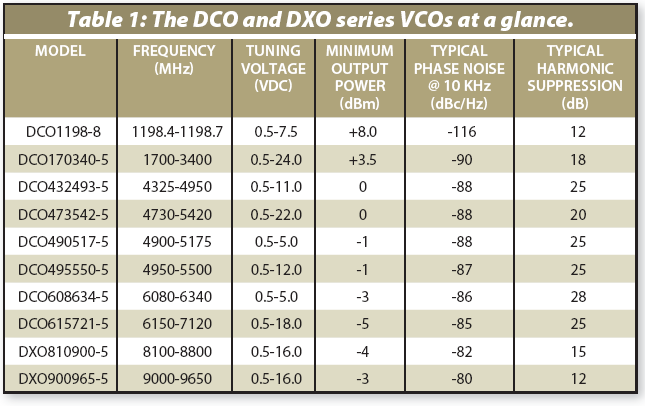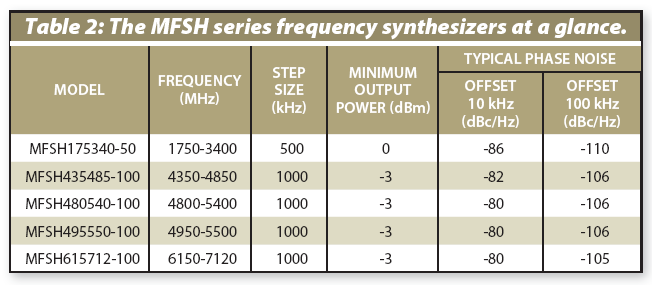Compact frequency synthesizers fill many needs in modern communications systems. To achieve fullsized performance in miniature packages, Synergy Microwave has developed a line of compact frequency synthesizers that leverage novel, patented voltage-controlled-oscillator (VCO) technology1- 8 for the stability and low noise needed for emerging wideband, high-datarate wireless communications systems.
To overcome the limitations of VCOs based on three-dimensional (3D) resonators, which do not lend themselves to integratedcircuit (IC) realizations, the designers at Synergy Microwave were able to shrink planar resonators while also applying a unique evanescent-mode electromagnetic (EM) coupling mechanism to improve the loaded quality factor (Q) of the coupled planar resonators and thus reduce the phase noise. The result is a line of patent-pending coupled-planar-resonator VCOs that fit in packages just 0.3 x 0.3 in. but can match the phase-noise performance of much larger, high-Q resonator-based oscillators. The planar resonator approach also readily lends itself to semiconductor processing methods for fabrication of integrated-circuit (IC) reference oscillators using silicon CMOS/BiCMOS/ SiGe/GaAs technologies.
The new DCO and DXO series VCOs (Table 1, Fig. 1) are the miniature sources that enable the firm’s MFSH series of configurable wideband frequency synthesizers in compact surface-mount packages measuring just 0.6 x 0.6 in. The synthesizers offer wide bandwidths with excellent performance in terms of phase noise, harmonics, settling time, and sideband spurious, all with low power consumption.
Fig. 1
It is the miniature size of the discretedevice DCO and DXO series VCOs that make the surface-mount MFSH series synthesizers possible. VCOs based on IC technology can be made small, but at the cost of power consumption and tuning range. Synergy’s proprietary patented VCO technology is based on planar resonators and supports VCOs with as much as 2:1 bandwidths from 1 to 12 GHz, with phase-noise performance that challenges the best performance of high Q (ceramic/SAW) and low Q (lumped LC, printed transmission line) resonatorbased VCOs three times their size. The DCO and DXO VCOs are available in bands from 1100 to 9650 MHz. They can be delivered at standard and custom frequencies without the non-recurringengineering (NRE) costs associated with custom development.

VCO models are available for narrowband tuning (about 10 percent of center frequency), moderate bandwidth (about 50 percent of center frequency), and wideband tuning (greater than 100 percent of center frequency). The DCO and DXO VCOs are suitable for use as free-running sources as well as for space-saving synthesizer designs. They are designed for reliable performance from -40 to +85°C and are well suited for industrial, military, and commercial systems. They can be used with supply voltages of 2.1, 3.0, 3.3, 5, 8, and 12 V with supply current as low as 10 mA.

The tunable VCO technology, introduced earlier this year (see Microwaves & RF, June 2008, p. 92 and July 2008, p. 90), is based on the use of self-injectionlocked mechanism to produce stable output frequencies with low phase noise and low jitter. Because of their (low mass) printed coupled resonators, they are immune to high levels of shock and vibration, a major advantage over oscillators using crystal, ceramic, SAW, and YIG resonators. The tiny VCOs are RoHS compliant and can be supplied in tape-and-reel format for automated assembly. The production sources have been tested through 12 GHz. The lowpower, low-noise oscillator technology is currently available in discrete-component form but ready to make a transition to integrated circuits.
Figures 1(a) and 1(b)) show the block diagram and layout for the DCO/DXO VCOs. They employ a multicoupledstubs- tuned-planar-resonator (MCSTPR) approach, fabricated on low-loss 30-milthick dielectric material with dielectric constant of 3.38. The active device is a discrete silicon-germanium (SiGe) heterojunction- bipolar transistor (HBT).
The MCSTPR structure is modeled using a 2.5D or 3D EM simulator and incorporated into an optimized nonlinear oscillator circuit to achieve configurability and low-phase-noise operation over a desired frequency band. The nonlinear circuit model contains the oscillator’s active device, represented by its S-parameters. This partitioning of the oscillator into its modeled component parts works quite well, and the combination of the S-parameters and the nonlinear circuit model agrees closely with measured data from circuits already constructed. The SiGe HBTs are represented by large-signal S-parameters to better understand the behavior of the device under quasi-linear (low-signal drive level) and nonlinear (large-signal drive level) conditions. This approach improves the optimization cycles using harmonic-balance simulators such as Serenade/Ansoft/Nexxim/Ansys from Ansoft Corp. and the Advanced Design System (ADS) from Agilent Technologies to limits allowed by physics.
Figure 1(b) shows the oscillator layout, where the MCSTPR approach sets up optimum standing waves (within the resonator) and the noise impedance transfer function over the tuning range by controlling the optimized injection locking, mopt and the optimized mode tuning, ßopt. As an example of actual performance, model DCO473542-5 is designed for use from 4730 to 5420 MHz and provides low phase noise of -110 dBc/Hz offset 100 kHz from the carrier. Table 1 lists measured performance for a sampling of the miniature VCOs, although the product line is not limited to these models. Tunable DXO sources measure just 0.3 x 0.3 x 0.08 in. and provide performance comparable to DROs, but without the temperature sensitivity, size, and cost.
The new MFSH series of miniature frequency synthesizers take advantage of the small size and performance of the DCO and DXO oscillators to provide synthesized performance in a surfacemount package measuring just 0.6 x 0.6 in. The block diagram for a typical MFSH frequency synthesizer (Fig. 4) includes a VCO, phase-lock-loop (PLL) IC, charge pump, loop filter, amplifier, and voltage regulator. A typical unit, model MFSH495550-100, tunes from 4950 to 5500 MHz in 1-MHz steps with settling time of less than 1 ms and phase noise of -80 dBc/Hz offset 10 kHz from the carrier and -106 dBc/Hz offset 100 kHz from the carrier. The synthesizer draws typically 30 mA current from a 5-V supply. This is just one frequency band for a product line available for coverage from 1 to 8 GHz (Table 2).
Figure 5 shows a typical size comparison between a DCO/DXO oscillator and the MFSH frequency synthesizer. The DCO/DXO series of VCOs and MFSH series of synthesizers can be incorporated in other electronic devices to realize considerably small size and excellent performances comparable to larger products currently on the market.
The company is currently working to extend the technology to 18 GHz using patented N-push techniques. The oscillator/ synthesizer technology can operate as low as 100 MHz. Synergy Microwave Corp., 201 McLean Blvd., Paterson, NJ 07504; (973) 881-8800, Internet: www.synergymwave.com.


